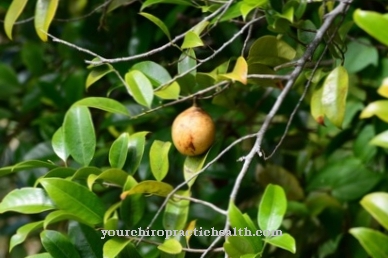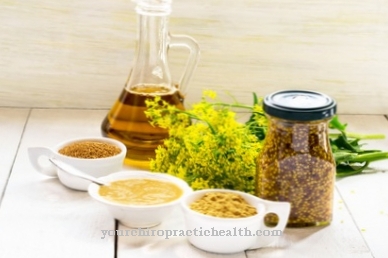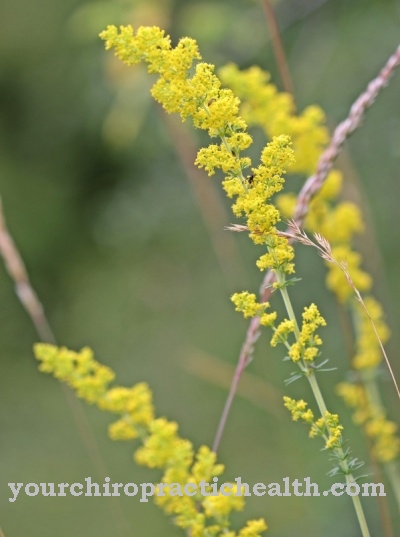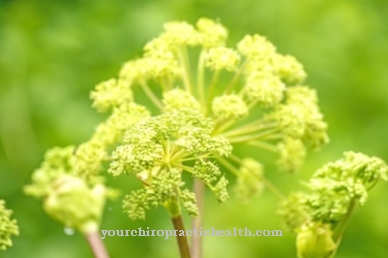As Benzoin is the name given to the resin from the benzoin or styrax tree. The resin gives off a pleasant, sweet scent and is mainly used in perfume production and aromatherapy.
Occurrence & cultivation of benzoin

Siam Benzoin grows in Thailand, Vietnam, Laos and Cambodia. As the name suggests, Sumatran benzoin is only found on the island of Sumatra in Indonesia.
The up to 20 meters high benzoin trees are evergreen and have a chocolate brown bark. The oval leaves, up to 10 centimeters long, are arranged alternately on the branches. During the flowering period, white flowers arranged in long clusters appear. The fruits of the Benzoe Bazmes are up to 12 millimeters long and contain the seeds. The brownish benzoin is obtained by cutting the tree trunk and curing it in the air.
Effect & application
The scent of the benzoin resin is balsamic and strongly reminiscent of vanilla. The resin owes its pleasant smell mainly to the aromatic esters. The main component is coniferol benzoate with a proportion of up to 80 percent. Other components are aromatic acids such as benzoic acid (about 20 percent) and aromatic aldehydes with a share of 1-2 percent. The aromatic aldehyde vanillin is responsible for the vanilla-like fragrance of the resin.
Typically, benzoin is offered in its original resin form. In this form, the resin is mainly smoked. In the Russian Orthodox Church, the resin from the benzoin tree is the main component of church incense. Not only the resin itself, but also the smoke smells balsamic and vanilla. The fragrance should convey a feeling of security, security and warmth.
Due to its relaxing effect, the benzoin is particularly suitable for smoking in the evening and can be complemented well with sandalwood, patchouli leaves, rose blossoms, cinnamon blossoms, tonka or star anise. In Ayurveda, the smoke from benzoin is also used as a remedy for respiratory diseases.
A thick, brownish essential oil can be obtained from the resin by means of an alcohol extraction. For this, the resin is placed in alcohol. 1 kg of essential benzoin oil can be obtained from 1.5 kg of resin. This is also known as a resinoid. The sweet and lovely scent of the resin is retained during the extraction. The essential benzoin oil also conveys a feeling of security and warmth and is both relaxing and anxiety-relieving.
But benzoin is not only good for the psyche, it also has a positive effect on the skin. Benzoe oil promotes the metabolism of the skin and helps sore skin to regenerate. Benzoin has an antimicrobial effect. The antimicrobial effect is less evident in bacteria, but more so in yeasts and fungi. This is why the essential oil is often used to prevent mycosis, for example in patients with diabetes mellitus.
Cancer patients can also benefit from the essential oil in radiation prophylaxis and aftercare. Benzoe oil also has a wound healing and epithelializing effect, so that it can be used well for poorly healing wounds. Benzoin can therefore also be used to prevent bedsores (decubitus prophylaxis) or to care for an ostomy in the case of an artificial anus.
The oil is also often used in acne treatment. Here one makes use of the anti-inflammatory effect. Benzoe oil also has a regulating effect and can rebuild skin flora that has been damaged by incorrect treatment. Like all essential oils, the oil obtained from the benzoin resin should always be diluted and never applied to the skin on its own. “Fatty” vegetable oils are suitable as carrier substances. Almond oil, jojoba oil or evening primrose oil are suitable to support the skin-caring effect of the benzoin resin.
An aerosol with benzoin can also be made for skin care. To do this, a few drops of the essential oil are added to rose hydrolate. The aerosol must be shaken well before use and can then be sprayed onto sore skin areas. Essential oils are not soluble in water. If the oil obtained from the benzoin resin is to be used in a full bath, it must first be emulsified. Cream, fat milk, honey or sea salt are suitable as emulsifiers.
Importance for health, treatment & prevention
Benzoin was known very early, especially on the South Arabian Peninsula. At that time, benzoin was also called Javanese incense. In ancient Egypt, the resin from the benzoin tree was a sought-after remedy. As an incense it was mainly used for disinfection, but it was also used in the production of healing ointments. The Greek doctor Pedanius Dioskorides described the positive effects of the resin on the skin and the respiratory tract as early as 50 AD.
Today, benzoin is mainly used in industry and not in medicine. The perfume industry in particular values benzoin for its warm scent and uses the resin primarily for oriental fragrances. Benzoin is also used as a fixative to protect oil, acrylic and pastel paintings and as a violin varnish. The benzoic acid extracted from the benzoin resin is used as a preservative in the food industry.
Today benzoin is used therapeutically more in alternative medicine. Naturopaths and doctors appreciate the resin for its nourishing and anti-inflammatory effect and use the essential oil for massages, for wound care, for therapeutic baths or in the fragrance lamp.




























